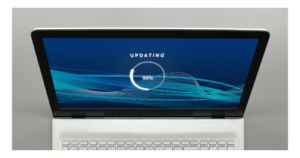Which is the most effective way of meeting with colleagues, followers, employees, clients, and prospects? Virtually or face-to-face?
McKinsey conducted a survey which found that 90% of organizations will adopt a mix of on-site and remote work in the post-pandemic era. This emerging way of working will inevitably mean some changes to how we meet. Hybrid meetings, virtual meetings with both remote and in-person attendees, are going to be an integral part of our “new normal”.
Running a hybrid meeting can be more complicated than a simple all virtual or all in-person one, but it’s time to master the art. Let’s take a quick look at what it takes to run efficient hybrid meetings:

What are hybrid meetings?
Hybrid meetings are a mix of virtual and in-person/face-to-face meetings. While your remote workers join you via a platform like Zoom or Microsoft Teams, in-person attendees sit together in a meeting room.
However, it’s not easy to organize seamless hybrid meetings. Stats tell us that 71.1% of event organizers say connecting in-person and virtual audiences is their biggest challenge.
If we talk about the basics of hybrid meetings; first, you should be able to share only what you need. Second, all the participants including remote attendees must be able to contribute and brainstorm. Recording meetings will help people who can’t attend or need to review a meeting later.
How to run a great hybrid meeting: 5 Practical Tips
The rapid adoption of technology is making life easier. Nevertheless, we’re still human and want to interact with other human beings. For a meeting organizer, the biggest challenge is to work with the bigger picture and engage the audience on a human level.

1. Take advantage of emerging technology
We understand how the pandemic has accelerated the use of technology to support virtual ways of doing things. For example, the innovation in video conferencing tools enabled us to attend meetings on the go across devices: tablets, phones, and PCs. Likewise, we’re seeing providers investing heavily in improving the hybrid meeting experience.
For instance, Zoom’s Smart Gallery feature will allow us to deploy artificial intelligence to detect individual faces. Microsoft is also working to develop effective tools for hybrid experience. So, keep looking for innovative tools and technologies to effectively combine in-person and virtual meetings.
Related: All You Need to Know About Smart Gallery and Why It’s Changing Hybrid Meetings

2. Consider your remote participants perspective
When preparing for a meeting, think about what your remote workers need to see and what will keep them stay engaged. For example, virtual participants in a meeting should be able to see shared presentations, faces of in-person attendees, whiteboards, etc.
At the same time, people attending in person are looking to have a slightly different experience. If in-person workers are also on their computers, they might as well have stayed home. So, you don’t want them to keep them on laptops for the sake of remote team members. This is where a high-quality video experience can make things easier for everyone.
Create an environment where your remote participants can see who is speaking and have a close-up view of presenters or wall charts. Make your remote team feel like they’re a key part of the meeting rather than clueless observers.
Related: How to plan a hybrid conference room setup


3. Make remote attendees full sized
While setting up your hybrid conference room don’t overlook the importance of giving your remote employees greater presence. One thing you can do is to set up two large monitors on each side of the room, displaying life-size panes of virtual attendees throughout the meeting.
Large displays make it so much easier for in-person attendees to accept remote attendees. In such an environment, both in-person and remote participants make sure to include them in conversations. To further enhance the environment, you can refine the voice of remote colleagues with the help of ceiling speakers.

4. Test your setup before meetings
Imagine a meeting has already started and you end up facing glitches in the video or audio. To avoid such situations, test your entire setup both for remote participants and in-person colleagues. Consider having a 5-10 minute rehearsal to get everyone comfortable with what participants will see and hear in the meeting. Also, test the software you’re using to conduct hybrid meetings.

5. Don’t forget to add some collaboration tools
Technology is evolving rapidly and helping companies perform optimally regardless of the changing workplace environment. So, be sure to explore tools to support your new way of meeting team members. This will help you level up the engagement. If collaboration is critical to your business success, don’t hesitate to implement robust collaboration tools. When we say tools, even a piece of paper and a pen can help teams explain things.
Related: 9 Tools That Can Help Remote Teams Communicate Better
A competent facilitator is an integral part of successful hybrid meetings. To be highly efficient, you should encourage your team to develop facilitation skills to better perform in a new hybrid meeting universe.
Closing thoughts
As the pandemic winds down, an increasing number of people are either working from home or splitting their time between home and office. This means we can expect hybrid meetings to become the new normal. As we know, hybrid meetings involve two different settings. Your job is to learn the art of creating a meeting environment that meets the needs of both in-person and remote employees.

